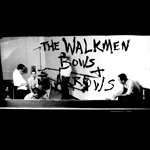|
|
 |
Dusted Reviews
Artist: The Walkmen Album: Bows + Arrows Label: Record Collection Review date: Apr. 20, 2004 |

|
|
|
 |
Bows + Arrows opens with Hamilton Leithauser wanting more. Amid the sound of a hollow organ and wavering guitar line, he croons, "What's in it for me? / I came here for a good time," surveying the scene with a twinge of skepticism. The music wanders around rambling vocals, building slowly, then ends without resolution. And so The Walkmen's sophomore full-length begins largely where Everyone Who Pretended to Like Me Is Gone left off: with weary ambivalence. But whereas Everyone was, on the whole, unrealized, Bows + Arrows is more on-target. The songwriting and production are sharper and the scope is decidedly larger, capturing the band’s conflicting urge to play the introspective balladeer and the pub-crawling mod-rocker.
Following the album’s sedate opener, “The Rat” quickly shifts the record’s tempo. Paul Maroon’s distorted guitar and Matt Barrick’s barrage of drums produce a frenzied wall of noise. Leithauser belts, “You’ve got a nerve to be asking a favor / You’ve got a nerve to be calling my number / Can’t you hear me? / I’m beating on the wall.” One part U2, two parts Stooges, the epic qualities of “The Rat” rival any number of the Survivor classics from the Rocky soundtrack. Throughout the song, the music continually develops in a series of unrelenting crescendos. One can’t help but imagine gongs crashing and blown amps toppling over. The dynamic “Little House of Savages” highlights the band’s strong rhythm section. Jagged guitar riffs encounter alternating drumbeats while images of passing cars and forgotten friends work their way through the treble – three worthwhile minutes dedicated to the banalities of everyday life.
While both singles will surely excite rock fans, the strength of the record lies in its ability to shift from rowdy to restrained with ease. Tracks like “138th Street” and “New Years Eve” are more reminiscent of Tin Pan Alley than ’60s garage rock. The Walkmen draw on influences long forgotten by many of their peers. At a time when moogs are too often used to achieve a “retro” new wave sound, The Walkmen reach back even further. Their use of the piano is at times unmistakably vaudevillian, and the dreamy “Hang on Siobhan” was inspired by an old Appalachian standard. Perhaps the band's greatest asset is the ability to own what they imitate; even when the muse is borrowed, it breathes anew.
Disillusionment dominates Bows + Arrows. Lyrics touch on failed experiences and seasoned cynicism: “When I used to go out I’d know everyone I saw / Now I got out alone if I go out at all” Leithauser sings on “The Rat.” Still, the album's gray hairs are never overbearing. The Walkmen deserve credit for deftly toeing the very thin line between aping the past and appreciating it.
By Ronnie Saha
|







